Department of Petroleum Engineering, Marvdasht Branch, Islamic Azad University, Marvdasht, Iran
Corresponding author Email: dabiri211@yahoo.com
Article Publishing History
Received: 16/12/2016
Accepted After Revision: 14/03/2017
Oil reservoirs are usually consist of hydrocarbons (oil and gas) and bottom water. The natural depletion of the reservoir occurs by the natural energy of the reservoir. Reservoirs pressures are usually high in the beginning and this will transmit the fluid from the reservoir to the surface. However, after some time of production, when the reservoir pressure falls down, water comes into the formation and starts to produce through the wellbore. This happens because of the disturbance in gravitational force in the reservoir, which results in water production along with oil. Reducing well productivity, water separation and handling, corrosion and environmental issues are the major challenges associated with water coning phenomena. In this study, the black oil model of ECLIPSE software was used to study the water coning issue in an oil reservoir. Different production plans were studied and their effect on water coning was investigated. In addition, the best production plan was introduced using simulation results. The simulation results showed that pressure draw down in the reservoir decreased with decreasing oil production rate, which inherently decreases the water production rate. Moreover, the simulation results showed that oil recovery factor can be increased significantly by decreasing the amount of water production.
Water Coning, Oil Production, Improved Oil Recovery, Eclipse
Dabiri A, Karaei M. A, Azdarpour A. Simulation Study of Oil Production Rate and Water Coning in Oil Reservoirs Using ECLIPSE Software. Biosc.Biotech.Res.Comm. 2017;10(1).
Dabiri A, Karaei M. A, Azdarpour A. Simulation Study of Oil Production Rate and Water Coning in Oil Reservoirs Using ECLIPSE Software. Biosc.Biotech.Res.Comm. 2017;10(1). Available from: https://bit.ly/2yJCYVQ
Introduction
Water production from oil wells is a common occurrence in oil fields. Water coning, increasing water oil contact level, and water fingering especially in injection wells are the major reasons of waster production in oil fields. In general, water production is not a favorable occurrence. Reducing well productivity, water separation and handling, corrosion and environmental issues are the major challenges associated with water coning phenomena (Armenta and Wojtanowicz, 2002, Bahadori and Nouri, 2012; Mauriya et al., 2014; Carpenter, 2015; Moortgat and Firoozabadi, 2016; Kamari et al.,
2016).
Disturbance in gravitational and viscous force around the perforated area is the major cause of water coning in oil fields. An upward dynamic force upon reservoir fluid is induced by the flow of oil from the reservoir to the well. Adding the effects of pressure draw down at the wellbore will causes the water to move upward and be produced at the surface (Pang et al, 2008, Ansari and Johns, 2013; Dos Santos and Oliveira, 2014; Ghane Ezabadi, 2015; Hatzignatiou et al., 2016; Carpenter, 2016; Zeinijahromi and Bedrikovetsky, 2015; Zeinijahromi and Bedrikovetsky, 2016).
Different factors including mobility ratio, the extent of penetration, vertical permeability, oil zone thickness, and most importantly the production rate are the major parameters that affect the severity of water coining. This phenomenon is more complicated in fractured reservoirs, where dual porosity exists, which results in the formation of two cones. In this case, two different cones with two different rates, one in matrix and one in fracture may form, which creates a very complicated situation at the surface (Egbe and Appah, 2005; Lakatos et al., 2014; Mohammed et al., 2014; Cinar et al., 2016; Li et al., 2016; Zemtsov and Lytkin, 2016).
Permadi and Jayadi (2010) proposed a new calculation method for determining the water coning in horizontal wells. The post breakthrough performance in horizontal wells was calculated and predicted using a semi empirical method in their study. They used two sets of field data where in the first case no water cut was observed and in the second case water cut occurred after production started. Results of prediction for both cases are in very good agreement with the field data.
In another study by Buranatavonsom (2011), water coning was managed successfully in a gas reservoir using downhole water pump flood. In this method, water coning is reduced significantly. In addition, it is not required to produce water into surface and also to drill a well for water production. Therefore, it can minimize cost of drilling and water treatment system. Moreover, in another study by Jin and Wojtanowics (2010), the feasibility of water coning control installation in reservoir with downhole water sink (DWL) was investigated. The DWL feasibility was tested with a simple analytical model derived in this study. Also, a good match was obtained when comparing the model-calculated data to real production data. Their work was comparable with the resulted presented in the literature (Qin et al., 2014; Alblooshi and Wojtanowicz, 2014; Anthony and Al-Mosaileekh, 2016; Muktadir et al., 2016; Yoshida and Hill, 2016).
In this study, different scenarios including different oil flow rate, water cut, blocking of critical penetration intervals and drilling of new horizontal wells were investigated and the best production plan was selected accordingly.
Materials and Methods
Reservoir Characteristics And Simulation Study
The oil reservoir is an under saturate oil reservoir with no initial gas cap present. Water, oil and solution gas are the available phases exists in the reservoir, where oil is in contact with water in the fifth layer. Table 1 represents porosity and permeability in three directions (Z, Y, Z). On the other hand, Table 2 represents the properties of reservoir rock and fluid. The reservoir is divided into three directions of X, Y, and Z. Black oil model of ECLIPSE software has been used to simulate water coning in this reservoir. Equations were solved fully implicitly since the error term is minimized as compared to Impes method. The solution method in this study was recommended by the previous authors in the literature (Zeinijahromi et al., 2014; Langaas and Hjellbakk, 2015; Zhao et al., 2016; Zeinijahromi and Bedrikovetsky, 2016).
| Table 1: Reservoir rock characteristics | ||
| Porosity | (layer 1) (ave.) | 0.04425 |
| (layer 2) (ave.) | 0.01485 | |
| (layer 3) (ave.) | 0.0406 | |
| (layer 4) (ave.) | 0.02955 | |
| (layer 5) (ave.) | 0.037 | |
| Permeability X (md) | (layer 1) (ave.) | 2455 |
| (layer 2) (ave.) | 11 | |
| (layer 3) (ave.) | 825.26 | |
| (layer 4) (ave.) | 20 | |
| (layer 5) (ave.) | 1300 | |
| Permeability Y (md) | (layer 1) (ave.) | 2455 |
| (layer 2) (ave.) | 11 | |
| (layer 3) (ave.) | 825.26 | |
| (layer 4) (ave.) | 20 | |
| (layer 5) (ave.) | 1300 | |
| Permeability Z (md) | (layer 1) (ave.) | 11 |
| (layer 2) (ave.) | 1.09 | |
| (layer 3) (ave.) | 71 | |
| (layer 4) (ave.) | 50.44 | |
| (layer 5) (ave.) | 84 | |
| Table 2: Reservoir characteristic | |
| Dx (ft) (ave.) | 260 |
| DY (ft) (ave.) | 300 |
| DZ (ft) (ave.) | 115 |
| Tops (ft) | 2552 to 3235 |
| Net to Gross ratio (NTG) | 1.0 |
| Pressure (psia) | 5684 |
| Temperature (F) | 260 |
| Initial Oil saturation | 0.8268 |
| Initial Gas saturation | 0.0 |
| Initial Water saturation | 0.1732 |
| Density (lb/ft3) | 52.86 |
| API | 35 |
The production from this reservoir was started in 1998 using 12 production wells. Oil production rate is the main parameters that affect water coning severity in oil reservoirs. Figure 1 represents the three-dimensional picture of the wells in this reservoir. Thus, five different scenarios were introduced and their effect on water coning was investigated.
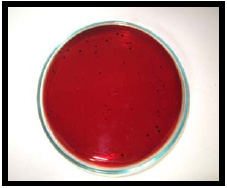 |
Figure 1: Three dimensional location of production wells |
Results
In the first scenario, oil production rate from all wells were assumed to be as default values and no limitation on production rate was applied. The main objective of this production scenario is to observe the productivity of each well. As is shown in Figure 1, well number 5, 9, 10, and 11 are near the water level in the reservoir and the possibility of water production in these wells are higher than the other wells. Thus, simulation study was focused on the behavior of these wells. Figures 2-5 represents the oil and water production from these four production wells. As shown in these wells, after some time of production from this reservoir, water starts to come to the surface and produce along with oil.
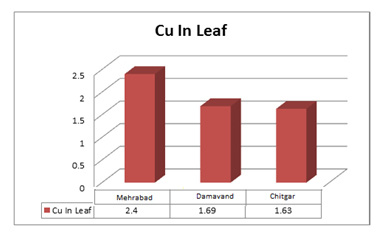 |
Figure 2: Total oil and water production from well number 5 |
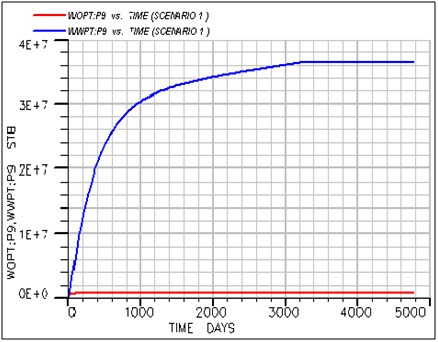 |
Figure 3: Total oil and water production from well number 9 |
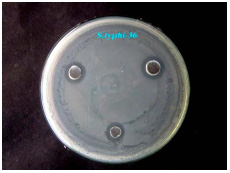 |
Figure 4: Total oil and water production from well number 11 |
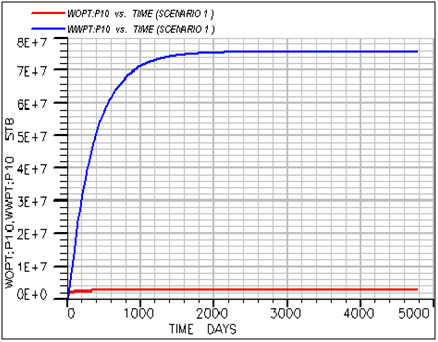 |
Figure 5: Total oil and water production from well number 10 |
In the second scenario, production occurs from all the wells under constant production rate of 2000 bbl/day and the results are shown in Figure 6. As shown in this figure, the duration of water production is reduced with increasing. In addition, with increasing the oil production form the reservoir, water production increases as well.
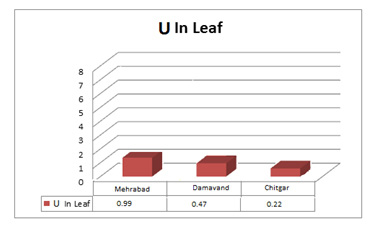 |
Figure 6: Total oil adn water production in the second scenario |
In the third scenario, production occurs from all the wells under constant production rate of 1500 bbl/day. As shown in this figure, the duration of water production is increased with increasing. In the forth scenario, production occurs from all the wells under constant production rate of 1000 bbl/day. As shown in this figure, the duration of water production is increased with increasing. In the fifth scenario, production occurs from all the wells under constant production rate of 500 bbl/day. The simulation results showed that water production is decreased with oil production. In addition, a lesser amount of water is produced at the surface as compared to other scenarios. In addition, reducing the oil production rate also increases recovery factor. Figure 7 represents a comparison on total amount of water production from this reservoir under different scenarios.
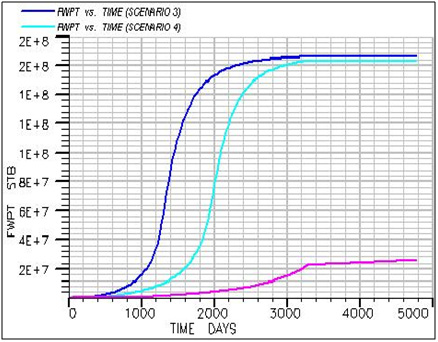 |
Figure 7: Comparison of the total water production in the third, forth and fifth scenario |
Another conclusion from the simulation study is that with decreasing oil production rate, recovery factor is increased. In addition, the total amount of produced is reduced as well. This happens because by lowering the oil flow rate, pressure draw down is reduced, thus the water movement to upper layers is delayed and reduced. Table 3 represents a summary of the total amount of oil and water production, recovery factor and water cut level under these five production scenarios.
| Table 3: summary of production rates under different scenarios | ||||||
| Scenario | Recovery factor (%) | Total water prodcution,
FWPT (STB) |
Formation water cut,
FWCT (%) |
Total formation oil prodcution,
FOPT (STB) |
Oil prodcution rate (bbl/day) | Number of production wells |
| NO. 1 | 19.44 | 1.703×108 | 0.995 | 19873336 | default | 12 |
| NO. 2 | 25.36 | 1.671×108 | 9.997 | 25924804 | 2000 | 12 |
| NO. 3 | 25.59 | 1.660×108 | 0.991 | 26157852 | 1500 | 12 |
| NO. 4 | 25.58 | 1.632×108 | 0.935 | 26149984 | 1000 | 12 |
| NO. 5 | 25.55 | 26346124 | 0.391 | 26157336 | 500 | 12 |
Discussions
Liminar flow condition exists in the wellbore when the a well is producing with constant flow rate and pressure gradient. In this case, viscous forces are less than the gravitational forces in the well, which inhibit the prodcution of cone in the well. On the other hand, when the pressure drop is signifcant in the wellbore, viscose forces are dominant over the gravitational forces. This creates afavorable condition for the cone to occure. Water coning in the wellbore continues to increase with incrasing the pressure drop in the wellbore (Bautista et al., 2014; Pal and Mandal, 2015; Izwan Ismail, 2015a; Desamal et al., 2015; Loh and Premanadhan, 2016). At the optimum flow rate of the well, viscous forces are always lower than the gravitational forces, which inhibites the water coning to achive to the wellbore. In cases where production flow rate is more than the optimum flow rate of the well this water coning occurs, which results in water prodcution at the surface (Izwan Ismail, 2015b; Liu and Bai, 2015; Hatzignatiou et al., 2016; Rozhko, 2016; Cazarez-Candia and Piedra-González, 2017). The same pohenomenon happend in this study as shown in Figures 2-7.
Conclusions
Water production is affected by the pressure draw down in the wellbore. Decreasing oil prodcution rate decreases the pressure draw down in the formation, thus decreases the amount of water production at the surface. Changing oil production rate is only effective when no water coning is occurs. In addition, oil recovery factor is increased by decreasing the total amount of water production from the formation.
Acknowledgment
The authors would like to appreciate the Department of Petroleum Engineering, Marvdasht Branch, Islamic Azad University, Marvdasht, Iran for the provision of the laboratory facilities necessary for completing this
work.
References
- Alblooshi, Y.A., Wojtanowicz, A.K. (2014) Multi-Lateral Wells with Downhole Water Control and Disposal in Heavy Oil Reservoirs with Bottom Water – A Case Study. Abu Dhabi International Petroleum Exhibition and Conference, 10-13 November, Abu Dhabi, UAE.
- Ansari, R.Z., Johns, R.T. (2013). Superposition of steady-state coning solutions for multiple wells with reservoir boundaries. Journal of Petroleum Science and Engineering, 108: 362–369.
- Anthony, E., Al-Mosaileekh, S. (2016). Downhole Water Sink Technology Improves Recovery and Rates from Strong Water Drive Reservoirs in North Kuwait – A Pilot Case Study. International Petroleum Technology Conference, 14-16 November, Bangkok, Thailand.
- Armenta, M., Wojtanowicz, A. (2002). Severity of Water Coning in Gas Wells. SPE Gas Technology Symposium, Alberta, Canada.
- Bahadori, A., Nouri, A. (2012). Prediction of critical oil rate for bottom water coning in anisotropic and homogeneous formations. Journal of Petroleum Science and Engineering, 82-83: 125–129.
- Bautista, E.V., Meneses Barillas, J.L., Dutra Jr, T.V., da Mata, W. 2014. Capillary, viscous and gravity forces in gas-assisted gravity drainage. Journal of Petroleum Science and Engineering, 122: 754–760.
- Buranatavonsom, B. (2011). Water Coning Management in Gas Reservoir via Downhole Water Dump Flood. SPE Annual Technical Conference and Exhibition, Colorado, USA.
- Carpenter, C. (2015). Optimized Design of Autonomous Inflow-Control Devices for Gas and Water Coning. Journal of Petroleum Technology, 67(12): 70-71.
- Carpenter, C. (2016). Optimization of Upper Burgan Reservoir Multilateral Well With Inflow-Control Device. Journal of Petroleum Technology, 68(2):68-69.
- Cazarez-Candia, O., Piedra-González, S. (2017). Modeling of heavy oil-water core-annular upward flow in vertical pipes using the two-fluid model. Journal of Petroleum Science and Engineering, 150: 146–153.
- Cinar, Y., Shehab, M.A., Dallag, M.M., Jama, A.A. (2016). Automated Surveillance and Diagnostic Workflow for the Management of Water Production in Naturally-Fractured Carbonate Reservoirs. SPE Annual Technical Conference and Exhibition, 26-28 September, Dubai, UAE.
- Desamala, A.B., Dasmahapatra, A.K., Mandal, T.K. (2015). An appraisal of viscous oil–water two-phase flow through an undulated pipeline in peak configuration. Experimental Thermal and Fluid Science, 68, 177–186.
- Dos Santos, M.D.L., Oliveira, F.R. (2014) Fault Reactivation as Mechanism of Early Water Production in Unconsolidated Sandstones Reservoirs. SPE Annual Technical Conference and Exhibition, 27-29 October, Amsterdam, The Netherlands.
- Egbe, T., Appah, D. (2005). Water Coning Diagnosis Using Spectral Analysis. Nigeria Annual International Conference and Exhibition, Nigeria.
- Ghane Ezabadi, M., Ramli, A.S., Ataei, A., Tg Othamn, T. R. (2015). Challenges in Modeling of High Clay Volume Gas Reservoir with No Water Production. SPE/IATMI Asia Pacific Oil & Gas Conference and Exhibition, 20-22 October, Nusa Dua, Bali, Indonesia.
- Hatzignatiou, D.G., Askarinezhad, R., Giske, N.H., Stavland, A. (2016). Laboratory Testing of Environmentally Friendly Sodium Silicate Systems for Water Management Through Conformance Control. SPE Production & Operations, 31(4): 337-350.
- Izwan Ismail, A.H., Ismail, I., Zoveidavianpoor, M., Mohsin, R., Piroozian, A., Misnan, M.S., Sariman, M.Z. (2015) Experimental investigation of oil–water two-phase flow in horizontal pipes: Pressure losses, liquid holdup and flow patterns. Journal of Petroleum Science and Engineering, 127: 409–420.
- Izwan Ismail, A.H., Ismail, I., Zoveidavianpoor, M., Mohsin, R., Piroozian, A., Misnan, M.S., Sariman, M.Z. (2015). Review of oil–water through pipes. Flow Measurement and Instrumentation, 45: 357–374.
- Jin, L., Wojtanowicz, A.K. (2010). An Analytical Model for Water Coning Control Installation in Reservoir With Bottomwater. Journal of Canadian Petroleum Technology, 49 (5): 65-70.
- Kamari, A., Mohammadi, A.H., Bahadori, A. (2016). On the determination of breakthrough time for water coning phenomenon in oil reservoirs. Petroleum Science and Technology, 34 (1): 44-49.
- Lakatos, I., Lakatos-Szabo, J., Szentes, G., Vago, A. (2014). Restriction of Water Production in Gas Wells by Induced Phase Inversion: Field Case Studies. SPE International Symposium and Exhibition on Formation Damage Control, 26-28 February, Lafayette, Louisiana, USA.
- Langaas, K., Hjellbakk, A. (2015). Integrated Reservoir Modelling of the Alvheim Field. SPE Bergen One Day Seminar, 22 April, Bergen, Norway.
- Li, K., Liu, C., Zhang, C., Jiang, P., Lei, X., Gao, H., Jing, F. (2016). A New Method for Estimating the Production Performance of Water Flooding. SPE Asia Pacific Oil & Gas Conference and Exhibition, 25-27 October, Perth, Australia.
- Liu, W., Bai, B. (2015). Swirl decay in the gas–liquid two-phase swirling flow inside a circular straight pipe. Experimental Thermal and Fluid Science, 68: 187–195.
- Loh, W.L., Premanadhan, V.K. (2016). Experimental investigation of viscous oil-water flows in pipeline. Journal of Petroleum Science and Engineering, 147: 87–97.
- Maurya, A.K., Mahto, V., Sharma, V.P., Laik, S. (2014) Study of the Potential of Amino Resin to Control Excessive Water Production in the Indian Oilfields. Petroleum Science and Technology, 32 (12): 1443-1447.
- Mohammed, S.A., Aggour, M., Fraim, M., Aboegila, A., Farooqui, M., Al-Kharaz, H., Ashkanani, M., Marmoush, M. (2014) Development of an Online, Non-Intrusive Means for Detecting Onset of Formation Water Production in Gas Flow Lines. International Petroleum Technology Conference, 19-22 January, Doha, Qatar.
- Moortgat, J.B., Firoozabadi, A. (2016). Water Coning, Water, and CO2 Injection in Heavy-Oil Fractured Reservoirs. SPE Reservoir Evaluation & Engineering. Article in press: http://dx.doi.org/10.2118/183648-PA.
- Muktadir, G., Amro, M., Schramm, A. (2016). Review and Applicability of Downhole Separation Technology. SPE Middle East Artificial Lift Conference and Exhibition, 30 November-1 December, Manama, Kingdom of Bahrain.
- Pal, D., Mandal, G. (2015). Mixed convection–radiation on stagnation-point flow of nanofluids over a stretching/shrinking sheet in a porous medium with heat generation and viscous dissipation. Journal of Petroleum Science and Engineering, 126: 16–25.
- Pang, Z., Cheng, L.S., Xu, J.F., Feng, R.Y. (2008). Application of material balance method to nitrogen anti-water-coning technology. Petroleum Exploration and Development, 35 (2): 234-238.
- Permadi, P., Jayadi, T. (2010). An Improved Water Coning Calculation for Horizontal Wells. SPE Russian Oil and Gas Conference and Exhibition, Moscow, Russia.
- Qin, W., Wojtanowicz, A.K., Li, H. 2014. Improved Thermal Heavy Oil Recovery from Strong Bottom-Water-Drive Reservoir by Combining SAGD with Downhole Water Sink. SPE International Heavy Oil Conference and Exhibition, 8-10 December, Mangaf, Kuwait.
- Rozhko, A.Y.(2016). Two-phase fluid-flow modeling in a dilatant crack-like pathway. Journal of Petroleum Science and Engineering, 146: 1158–1172.
- Yoshida, N., Hill, A.D. (2016) Comprehensive Modeling of Downhole Temperature in a Horizontal Well with Multiple Fractures. SPE Asia Pacific Hydraulic Fracturing Conference, 24-26 August, Beijing, China.
- Zeinijahromi, A., Bedrikovetsky, P. (2016). Water Production Control Using Low-Salinity Water Injection. SPE Asia Pacific Oil & Gas Conference and Exhibition, 25-27 October, Perth, Australia.
- Zeinijahromi, A., Bedrikovetsky, P. (2015). Controlling Excessive Water Production Using Induced Formation Damage. SPE European Formation Damage Conference and Exhibition, 3-5 June, Budapest, Hungary.
- Zeinijahromi, A., Al-Jassasi, H., Zhang, Y., Begg, S.H., Bedrikovetsky, P. (2014). Edge-Water Drive Recovery Enhancement by Induced Fines Migration. SPE Asia Pacific Oil & Gas Conference and Exhibition, 14-16 October, Adelaide,
Australia. - Zemtsov, Y.V., Lytkin, A.E. (2016). Supplementary evaluation of the efficiency of water shutoff in production wells (Russian). Oil Industry Journal, 2016(3): 102-104.
- Zhao, H., Kang, Z., Zhang, X., Sun, H., Cao, L., Reynolds, A.C. (2016) A Physics-Based Data-Driven Numerical Model for Reservoir History Matching and Prediction With a Field Application. SPE Journal, 21(6): 2175-2194.


